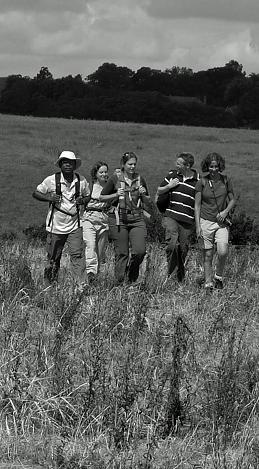|
What You Need For Our Walks:
|
Most
of our walks, in the flatter
parts of England -
Walking
boots: ideally you should
wear boots as these provide some
ankle support, which can be
necessary even in the flattest
areas. These can be leather or
fabric and should be waterproofed
as necessary. However, for many
of our local walks trainers will
suffice, particularly in the
summer, but you should note that
they may not be waterproof and
could get muddy, so you should
bring spares to drive home
in.
Waterproof
clothing: You should always
carry some sort of raincoat, even
on a very short walk or with a
good forecast - better to carry
it and not need it than get very
wet! If you have them, carry
overtrousers as well.
Other
clothing: Your other clothing
can just be "normal" clothes -
loose fitting or stretchy
trousers (to allow easy
movement), t shirt, and fleece or
jumper etc. You should not wear
jeans as if these get wet they
will stay wet and cling to your
legs - not much fun! In summer
you may prefer to wear
shorts.
Headwear
and handwear: During the
winter you should carry a wooly
or similar hat, and gloves. In
summer you should have a sunhat
or cap etc.
|

|
|
Sometimes
we are more ambitous and go up
big hills in the Peak District,
Lake District, Dartmoor, Scotland
etc, for these walks you need to
be a bit better prepared
-
|

|
Headwear:
A surprisingly large amount
of heat is lost via the head, so
a woolly hat is always a good
idea and should always be
carried, especially during the
winter. A cap may prove useful in
keeping sun from your eyes, if
the weather demands.
Bodywear:
Layering is the buzz word here
e.g. T-shirt, shirt, jumper &
fleece. Remember, if walking in
hilly areas the weather on the
tops can be very different to
that in the valley, so carry
spares. Lots of thin layers are
best as they allow your
temperature to be controlled more
effectively. Although you may not
want to carry too much you should
carry enough spare clothing to
keep warm if you have to
stop.
Rainwear:
A
waterproof and windproof jacket
should be carried all year round.
Waterproof trousers should also
be carried if you have
them.
Handwear:
Gloves
or mittens, preferably
waterproof, should be carried all
year round.
|
|
Legwear:
Denim should not be worn in
these areas because once it gets
wet it stays wet. We may not let
you walk if you turn up wearing
jeans. Instead, choose materials
that are quick drying and wind
resistant - tracksuit bottoms,
corduroys or combat trouser are
all fine. Gaiters can prove
invaluable when crossing streams
and boggy ground.
Footwear:
Socks - some form of loop
stitch is best and wool is
warmest. Most people wear two
pairs for extra
comfort.
Boots:
either leather walking boots,
waxed for waterproofing or
properly treated fabric walking
boots
These
items will be needed all year
round, even in
summer
|
|
If
you are in any doubt about the
type of area we will be walking
in, and therefore what clothing
and equipment you will need,
contact the walk leader or
weekend organiser in
advance.
Please
Note that walk leaders have the
absolute discretion to refuse to
take someone who is not properly
clothed, shod and equipped for
the prevailing conditions. This
is for your own
safety.
|
|
Rucksack
You
will need a rucksack of some sort
for all walks - this must be
large enough to carry your food
and drink and adequate clothing
for the conditions (e.g.
rainwear, spare fleece - Or to
put your fleece etc in if you
need to take it off). It's a good
idea to line it with a
heavy-gauge plastic bag, or get a
rain cover for the outside of
it.
Inside
Your Rucksack: Spare
clothing, packed lunch, packet of
wine gums etc. for extra energy
or to pass around, camera,
non-glass drinks bottle, money
(for the pub), sunglasses (useful
in all seasons) and suncream (for
the optimists!). On walks in
hilly or exposed areas you should
also carry a torch (just in case)
and if possible a whistle and
orange plastic bivi bag (for
emergencies).
|
|
Food
& Drink
For
daywalks you will only need your
packed lunch, but make sure you
bring plenty, as walking is
hungry work! Although we often
stop at a pub at lunchtime,
especially during local / low
level walks, there is not always
time to buy pub food so bring
sandwiches anyway.
Bring
plenty of water, too,
particularly during the warmer
months. Some people replenish
their supplies with water from
mountain streams, but this cannot
be officially recommended.
Alcoholic drinks should not be
carried, but Tango makes a good
supplement to water!
|
|
Weekends
Away
For
weekends away we now usually stay
in cabins so all you need is
spare clothes, toothbrush etc.
Food
is usually bought in bulk,
including packed lunches, so you
don't need to bring your own.
Evening meals are generally
supplied by the local hostelry so
you need to bring enough money to
pay for this (and several pints
as well!).
For
occasional camping weekends or
longer trips specific details
will be provided.
If
you find yourself responsible for
buying the food for a weekend
away you should find this list
helpful (based on 12 people for 1
day) -
|
Breakfast
24
sausages
24 bacon
9 eggs
2 black puddings
2 baked beans
1/2 cereal variety
boxes
2 pints milk
cooking oil
2 loafs bread white/
wholemeal
250g marg
2 cartons orange
juice
coffee
tea
|
Lunch
24
rolls
12 crisps
12 fruit drinks
8 apples
8 bananas
8 oranges
1 tuna
200g cheese
20 ham slices
|
Thanks
to Newcastle
University Fellwalking
Society
for allowing their clothing &
equipment list to be used and
modified.
|
|

